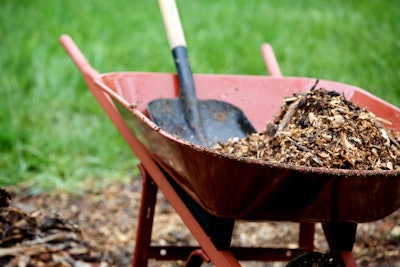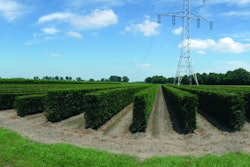
Mulching is one of the best things that you can do for your clients’ plant beds. It has many functional benefits such as helping to suppress weeds, insulating plants’ roots, and even assisting with water retention. Of course, a fresh coat of mulch also looks great, too!
If you’re already performing mulch installations, then you probably know that in order to get the most benefits out of mulch, it’s important that it’s properly installed.
But even if you’ve installed mulch properly, you can still end up with some icky growth atop of your clients’ mulch. If this is happening, your clients may be asking what it is—and how it got there. Evan Selby of Nature’s Mulch and Landscape Supply in Louisville, Kentucky, says that most of the time the growth found in mulch is fungus—which is normal. In fact, many different types of fungi actually help with the natural breakdown of mulch and can be a good thing.
Still, if there is growth in their plant beds, some clients may find it particularly unpleasant and want to get rid of it. Selby shares details on four of the most common types of fungus found in mulch and what you can do about them.
Bird’s Nest Fungus
According to Selby, Bird’s Nest Fungus gets its name because it resembles an egg-filled nest as it grows.
This is a naturally occurring fungus that can help with the decomposition process—and therefore will not cause any harm. As mulch breaks down, it helps to enhance soil fertility by making nutrients more readily available to plants. In addition, decomposed mulch should increase the soil’s ability to retain water.
Still, if clients are unhappy with the look of Bird’s Nest Fungus, it can be raked up. When you rake the fruiting bodies, you’ll break up the growth of these fungi.
Slime Mold
Slime Mold—also sometimes referred to as “Dog Vomit Mold”—is admittedly disgusting to find in mulch beds. As the name would suggest, it really does look like slime or vomit. If you (or your client) spot this mold at a later stage of growth, it may look powdery and white, says Selby.
This is another mold that you can leave be as it won’t cause any harm. However, many clients are likely to be grossed out and want it removed. Slime Mold can easily be broken up with a rake and washed into the soil with water. Or you can even scoop it up with a shovel and dispose of it, suggests Selby.
Artillery Fungus
This fungus likes to live on moist landscape mulch and although it won’t cause any harm to your plants, unlike the other types of fungus mentioned, this one can be a bit more problematic. The trouble, says Selby, is that Artillery Fungus can shoot spores up to 20 feet—and that can leave dark spots on light-colored surfaces such as house siding or even your car.
The best way to deal with Artillery Fungus is to prevent it from having the chance to grow and spread.
“Keep mulch beds well-raked to help them remain dry and aerated,” Selby advises. “Periodically raking the beds will not only fluff up the mulch and help it to look fresher, but it will prevent many fungi from growing in the first place.”
Mushrooms
A final type of fungi that must be mentioned is mushrooms. It’s quite common for your clients to find mushrooms growing in their mulch—and many of them are harmless. Your clients do not have to worry about mushrooms harming their plants. However, mushrooms can be dangerous—even deadly—if consumed. This may be a particular concern if your clients have children or pets and it’s worth advising them of this risk, warns Selby. You can help your clients’ plant beds to continue to look their best—and prevent safety risks—by removing and disposing of mushrooms.










